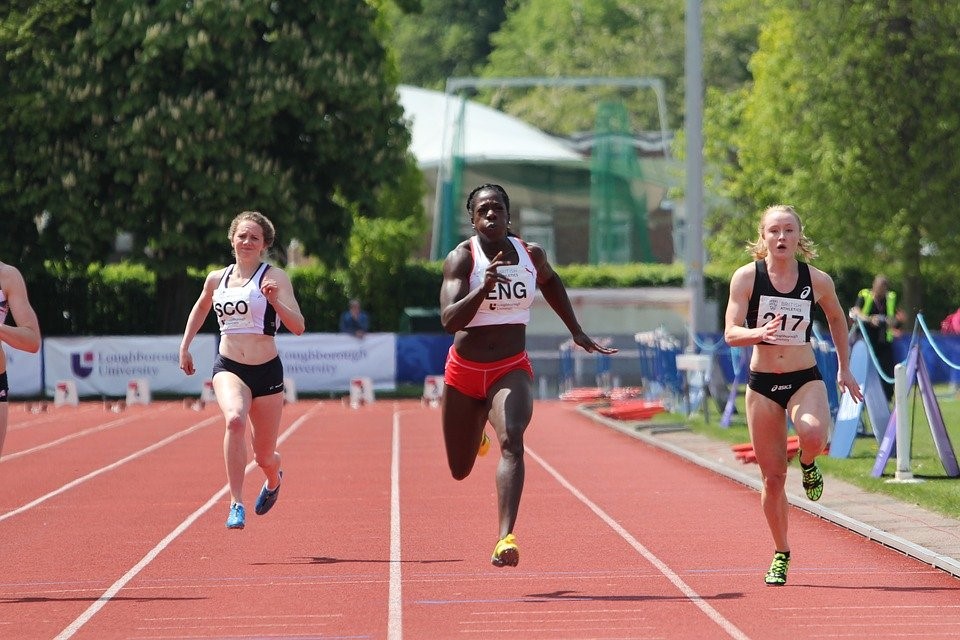Last Updated on October 27, 2022 by admin
If you are new to the sport of running, either as a workout or a profession, you have undoubtedly come across arguments such as sprinting vs jogging. To begin with, these two things might sound the same to you; after all, they are both types of running.
However, sprinting and jogging isn’t the same thing, and the kind of health benefits you get from each of them depends on your workout frequency and intensity.
Unfortunately, these two terms are often used interchangeably, making it even more confusing for novice runners. For the purpose of clarity, let’s take a look at sprinting vs jogging, find out what kind of differences there are, and the various health benefits that come with each one.
What’s the Difference Between Sprinting and Jogging?
To understand why these two types of exercises aren’t exactly the same and why the terms shouldn’t be used interchangeably, let’s take a quick look at the main differences between sprinting vs jogging:
- Jogging: This is a slow-paced or leisurely form of running where the runner keeps up the steady pace over a long distance during an extended period of time.
- Sprinting: This is an extremely fast-paced form of running where the runner keeps up the incredible pace over a very short distance during a short amount of time.
Typically, jogging is something people do when they want to work out their cardiovascular system through sustainable aerobic exercises. On the other hand, sprinting is a competitive sport that has been around since the very fast Olympic Games. Sprinters typically run over rather short distances:
- 100 meters or 328 feet
- 200 meters or 656 feet
- 400 meters or 1,312 feet
While these distances might seem manageable at first, it takes a lot of training and natural talent to compete professionally as a sprinter. The fastest sprinter in the world, Usain Bolt, ran the 100 meters’ sprint in just 9.58 seconds while the fastest woman, Florence Griffith-Joyner, did the same distance in just 10.49 seconds.
To give you an idea of how difficult these feats are to achieve, Usain Bolt and Florence Griffith-Joyner are incredibly talented individuals who do little else other than train for that sprint.
However, not every single one of us intends to compete in the Olympics. What about those who want to enjoy either one of these sports without the competitive edge? Is sprinting or jogging better for people who want to get and stay fit?
The simple answer is: Yes. Sprint training or jogging are both very beneficial forms of aerobic exercise. However, the specific benefits you get from either one depends on your reason for working out. It’s this reason that will also help you determine which between the two is good for you.
To properly highlight the differences between these two exercises, let’s look at the kind of muscles either one works.
Muscles Worked When Sprinting

Running, in general, makes use of some specific muscles. Sprinting in particular calls the following muscles into action:
- Hamstrings
- Glutes
- Hip flexors
- Quadriceps
- Core
- Calf muscles
Jogging also calls the muscles in your arms into action, albeit to a much lesser degree.
Muscles Worked When Jogging
Turns out, jogging and sprinting work out the very same muscle groups. The biggest difference between the two types of running lies in how the different muscle fibers are activated. When you are sprinting, you activate the fast-twitch muscle fibers; when jogging, you activate the slow-twitch muscle fibers. Here’s the difference:
- Slow-twitch muscle fibers – These are resistant to fatigue and excellent stabilization during cardio or aerobic exercises in general.
- Fast-twitch muscle fibers – These are typically larger and achieve fatigue much faster. They are also the muscle fibers that offer short-term contractions, which create the kind of explosive power you need to sprint. Activating them helps you build muscle mass and strength.
Simply put, your body will almost always use the slow-twitch muscles first and call in the fast-twitch muscles when you need an explosive burst of energy to carry out the movement. This explains the difference between sprinting and jogging quite succinctly – since sprinting is a fast-paced activity, it activates the fast-twitch muscle fibers, which are larger but achieve fatigue faster. On the other hand, jogging is a slow-paced exercise that activates the slow-twitch muscles designed for endurance.
The Benefits of Sprinting vs Jogging
As is the case with almost every type of exercise, when you begin debating which is better, you first must consider what the participant is looking to achieve. Are you thinking of exercising (running) to achieve better cardiovascular health, or are you looking to build muscle?
Are there injuries such as knee injuries that might prevent you from comfortably and safely participating in one exercise and not the other? It’s your particular fitness goals that will determine which one of these exercises is best for you.
That being said, let’s look at the kind of health benefits that come from each of these types of running exercises:
Weight Loss
If you are looking to lose weight, which of these two types of running exercises is best – jogging or sprinting? While both would work wonders for your body and overall weight loss ambitions in general, the truth is that running tends to burn more calories for every session than you would typically consume.
For you to lose weight, you need to burn more calories than you take in every day. You can easily reduce the number of calories you consume by changing your diet but to get better, faster results, you need to incorporate an aerobic exercise such as jogging.
Research shows that jogging for just 20 minutes can burn up to 250 calories in a person who weighs about 185 pounds.
If you are just starting out, depending on your current and target weight, you should consider jogging first. Although, if you are extremely unfit, then you might want to go for brisk walks before stepping up to jogging. Once you can maintain a 20-minute jogging session without feeling like you are about to keel over, you will have lost some weight and then move on to sprinting.
In short, if you are looking to lose weight, jogging is better. Once you have lost some weight, then sprint interval training might be the better option for improving your endurance and building muscle.
Heart Health
Cardiovascular health is by far one of the most important aspects of exercising. Anyone looking to get and remain fit needs to focus on cardio exercises that build up their hearts’ health. If this is your main focus, you might want to focus on jogging instead of sprinting. This isn’t to say that sprinting doesn’t help with cardio; it’s just to say that the kind of cardiovascular benefits you get when jogging is much better than what you get when sprinting.
Most of this benefit is because jogging calls for a steady, continuous pace which keeps your heart rate elevated. The more frequently you train and jog, the further the distance you can cover without running out of breath. This is how professional distance runners train.
The more you run, the higher your VO2 max increases (this is the amount of oxygen that your body can use at any given time or at once). The higher this number, the more you can exercise without stopping.
Ultimately, it’s not all about running further or faster. Aerobic exercises such as jogging have a host of health benefits that come with them. These benefits include:
- These exercises increase your resistance capacity and your energy levels, which in turn improve your overall condition.
- Cardio is good for calorie burn, speeding up your metabolism, and improving your BMI (Body Mass Index), all of which help you maintain the ideal weight.
- Cardio helps control your cholesterol levels (gets rid of LDL – bad cholesterol) while encouraging good cholesterol.
- It helps stabilize and balance sugar levels in your body, which lowers your risk of developing type 2 diabetes by reducing blood glucose levels.
- It can slow down aging. Research has found that regular aerobic exercise can reverse or even eliminate disease progression. Diseases such as atherosclerosis develop slowly over time. With a consistent aerobics workout, you can slow down this progression.
Finally, there is more to aerobic workouts than just the physical benefits. Running, in general, has a liberating effect that can calm the mind and help you develop a positive image of yourself, improving your self-confidence.
Helps Improve Your Core
The coveted abs – some of the most admired muscles in both men and women yet some of the most difficult to achieve. The problem with getting abs is that there is a lot more that goes into it than just doing random sit-ups every now and again. Your stomach hoards a lot of fat, and most of it is often on the surface, covering up those abdominal muscles that would chisel out to become killer abs.
If you want to get abs, you might want to incorporate some fat-burning running exercise into the mix. This will help burn calories in general and help burn up that layer of fat covering up your abs.
In this case, you are better of sprinting as opposed to jogging. While jogging will also help burn fat throughout your entire body, the explosive nature of sprinting does the job more efficiently. Sprinting is a good way to reduce abdominal and visceral fat quickly and reduce your overall fat mass, the circumference of your waist, and trunk fat.
Furthermore, sprinting brings with it an additional benefit in the form of EPOC. EPOC or excess post-exercise oxygen consumption is a phenomenon where your body continues to burn calories long after your workout session. This typically comes about thanks to the endurance you develop during regular sprints. Therefore, sprinting is the best form of running exercise for anyone looking to burn belly fat, improve their core support, and develop those enviable abs.
Build Muscle Mass
Running is typically associated with lean individuals with almost negligible BMIs and slender body frames. That’s at the very least true for long-distance running, which is very closely associated with jogging.
However, if you look at professional sprinters such as Usain Bolt and Tyson Gay, you will see that they have excellently defined muscles. That’s mostly because sprinting is a good way to develop muscle mass.
There is a study that found this to be truer in men than it is in women. Interval training where sprints are involved is one of the best ways for active men to develop muscle mass, reduce body fat, and get toned. Conversely, if you are looking to lose weight and stay lean, jogging is the best alternative for you.

How to Benefit from Both
Since sprinting and jogging both offer individual benefits, it’s natural to wonder whether or not you can’t have the best of both worlds. As it turns out, you actually can. Incorporating jogging and sprinting into your workout routines is one of the best ways to avoid plateaus in your training and fitness.
How do you do this, you might wonder?
The trick lies in first determining what it is you want to achieve. If you only want to be fit, maybe lose a few pounds, and maintain excellent cardiovascular fitness and health, then you should consider completing most of your runs by jogging. A good workout schedule would be to cover about 75% of your weekly runs at a leisurely jogging pace and dedicate the remaining 25% to sprinting.
Understanding the difference between sprinting vs jogging is an excellent way to get the best out of both these beneficial exercises. Once you realize how intense exercise works on your body, you can come up with a workout regimen that not only gets you fitter and a better physique with time but also keeps you from common injuries such as “runner’s knee.”

